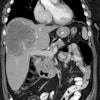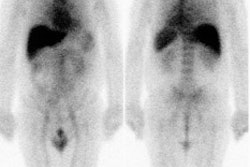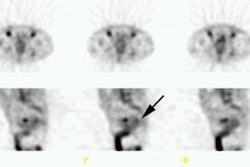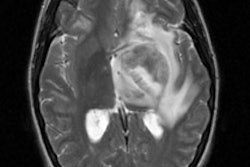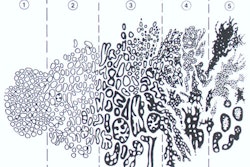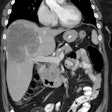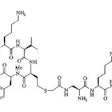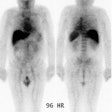Radionuclide Therapy for Tumors
Strontium-89 Chloride (Metastron):
Chemistry:
Strontium-89 has a physical half-life of 50.5 days [16]. It undergoes beta-minus decay with a beta emission of 1.46 MeV [16]. Maximum range of the beta-particle in tissue is about 8mm (average range is 2.4 mm [16]), therefore the greatest radiation dose is to the cortical and trabecular bone, with less to the radiosensitive marrow and minimal irradiation to adjacent soft tissues. Sr89 is chemically similar to calcium and the agent follows the biochemical pathways of calcium in the body. The agent is incorporated into the hydroxyapatite molecule in bone [12].
Distribution
Following intravenous injection of the agent it clears rapidly from the blood. Between 50% to 70% of the injected dose is retained in the skeleton. Preferential bone uptake occurs at sites of active osteoblastic activity. Biodistribution studies have shown significant retention in bone, but the retention varies with the degree of skeletal involvement with metastases- the more extensive the degree of skeletal metastases, the longer the retention. The biologic half-life of Sr-89 in normal bone is about 14 days, but the half-life in osseous mets can be over 50 days due to preferential retention in these sites [5]. In one study, 90 days after administration, 20-88% of the injected Sr-89 activity was found around metastatic bone lesions [18]. The concentration of Sr89 at sites of metastases may be as high as 5 to 10 times that in normal bone [11]. This allows a large therapeutic gain to occur in terms of total radiation dose delivered to tumor and non-tumor bearing bone. The ratio of bone-to-marrow uptake is 10:1 with a dose to the tumor averaging 20 to 24 Gy [1-4].
Excretion is primarily renal/urinary (66-80%) and is greatest during first 2 days after administration. Some gastrointestinal tract/fecal excretion also occurs (20-33%). Levels of Strontium in the urine for 7 to 10 days after treatment require routine personal hygiene measures for urine disposal, and advice to incontinent patients. No special precautions are necessary. Since there are no gamma emissions, the patient does not pose a radiation hazard. Cremation and postmortem examinations can be performed without risk to the technician.
Sr-89 for the Palliation of Painful Mets:
Sr-89 can provide effective palliation of bone pain in patients with disseminated bone metastases and can also improve quality of life for most patients [17]. The goals of this treatment are to improve quality of life and possibly survival. Patients eligible for therapy are those that are not responsive to the usual analgesic medication. Their pain should emanate from the areas shown to be abnormal on the bone scan. Pain not arising from these sites should not be considered for this treatment [6]. Sr89 therapy is probably not indicated in patients with an expected survival of less than 3 months, in patients with low blood counts, and in patients with disseminated intravascular coagulation [11].
For bone pain palliation an administered dose of 4mCi (or 40-60uCi/kg body weight [1.5MBq/kg]) is used. There does not appear to be an increasing response with increasing the administered activity, but myelotoxicity does increase with higher dosages [12]. The absorbed dose to the bone marrow is about 74 rad/mCi.
Between 65-75% of patients with painful bone metastases report pain relief following Sr-89 treatment, although complete pain relief is achieved in less than 20% of patients. Patients may note transient increased bone pain (painful flare) within the first 36 to 72 hours post-treatment (a flair response occurs in 10-20% of patients [18]). This is typically mild, self-limited, and controlled with analgesics. A flare usually heralds a good response to the therapy [16,18]. The onset of pain relief is generally within 7 to 21 days, with a mean duration of relief of about 6 months (up to 14 months [16]). Re-treatment can be performed at intervals of not less than 90 days (3 months). Re-treatment with Sr-89 within 6 weeks after the first dose has not been shown to further improve pain relief. This may be related to the long residence time of Sr-89 in metastatic lesions which interferes with subsequent tracer accumulation. Frequent therapies can also be complicated by greater marrow toxicity [5]. The more extensive the degree of skeletal metastases, the more likely the patient will not experience complete pain relief- this may be related to dilution of the tracer effect associated with diffuse uptake. Overall, Sr-89 appears to have results similar to local XRT for palliation of pain [7], although 2 to 3 weeks are typically required prior to the onset of clinical improvement and XRT achieves pain control more quickly. There is currently no objective evidence of tumor regression or correlation between improved bone scan and improved pain control following Sr-89 therapy. Sr-89 therapy has not been shown to affect patient survival- although PSA and acid phosphatase levels have been shown to decrease in prostate cancer patients following therapy.
Although Sr-89 therapy is beneficial in a large proportion of patients, there is a significant number of patients that are unresponsive (up to 30%) [15]. This may be related to the low dose rate at which radiation is delivered following Sr-89 therapy (less than 4 cGy/hr) [15]. This low dose rate may limit the agents effectiveness by allowing repair of sub-lethal radiation injury and continued proliferation of tumor cells [15]. The combination of Sr-89 with radiation therapy or chemotherapy may aid in increasing the response rate.
Combined use of Sr89 and certain platinum-mediated radiosensitizing chemotherapeutic agents appears promising [11,15]. The addition of low dose cisplatin (total of 35 mg/m2 in two divided doses) enhances the effect of Sr-89 therapy without significantly increasing myelotoxic side effects [15]. The combination of the two agents produces a significant improvement in pain palliation (seen in up to 91% of patients) and prolonging pain free survival [15]. The combination of the two agents may also produce a cytostatic effect on the metastatic bone disease [15].
Recent combined Sr-89 and external XRT studies demonstrate complete pain relief in 60% of patients [8]. Adjunctive XRT is also associated with a decreased incidence of recurrent pain at the initial site, as well as decreased development of new pain sites [9,10].
Complications of Sr-89 Therapy:
Hematologic Toxicity:
Mild myelosupression is seen in about 80% of patients [11]. Patients blood counts should be monitored weekly. Platelet count: Levels will decrease transiently by about 15-30%. Nadir occurs between 5-6 weeks after treatment with partial to complete recovery by 12 weeks. Treatment should be performed with caution in patients with platelet counts less than 60,000. White blood cell count: Levels decrease transiently by about 20% typically 2 weeks after treatment. Levels recover by 4 to 6 weeks. Treat with caution in patients with WBC < 2400.
REFERENCES:
(1) Eur J Nucl Med 1986; Blake GM, et al. Sr-89 therapy: Strontium kinetics in disseminated carcinoma of the prostate. 12: 447-454
(2) Br J Radiol 1987; Blake GM, et al. Strontium-89 radionuclide therapy: A dosimetric study using impulse response function analysis. 60: 685-692
(3) J Nucl Med 1992; Breen SL, et al. Dose estimation in strontium-89 radiotherapy of metastatic prostate carcinoma. 33: 1316-1323
(4) Eur J Nucl Med 1987; Blake GM, et al. Sr-89 radionuclide therapy: Dosimetry and hematologic toxicity in two patients with metastasizing prostatic carcinoma. 13: 41-46
(5) Nuclear Medicine Annual 1992; Mertens WC, et al. Recent advances in radionuclide therapy of bone metastases. Ed. Freeman LM. Raven Press, Ltd. New York. 69-89
(6) J Nucl Med 1999; Nair N. Relative efficacy of P32 and Sr89 in palliation in skeletal metastases. 40: 256-261
(7) Sem Onc 1993; Bolger. 20: 32
(8) J Nucl Med Technology 1993; Dickinson CZ, Hendrix NS. Strontium-89 therapy in painful bony metastases. 21: 133-137
(9) Int. J Rad Onc Bio Phys 1993; 225: 805-12
(10) Cancer 1993; Robinson RG. Strontium-89 - Precursor targeted therapy for pain relief of blastic metatstatic disease. 72: 3433-3435
(11) J Nucl Med 2001; Serafini AN. Therapy of metastatic bone pain. 42: 895-906
(12) Semin Radiat Oncol 2000; Silberstein EB. Systemic radiopharmaceutical therapy of painful osteoblastic metastases. 10: 240-249
(13) Radiotherapy and Oncology 1994; Quilty PM, et al. A comparison of the palliative effects of strintium-89 and external beam radiotherapy in metastatic prostate cancer. 31: 33-40
(14) Antibody, Immunoconjugates, and Radiopharmaceuticals 1990; McEwan AJB, et al. An evaluation of the safety and efficacy of treatment with strontium-89 in patients who have previously received wide field radiotherapy. 3: 91-98
(15) J Nucl Med 2002; Sciuto R, et al. Effects of low-dose cisplatin on 89Sr therapy for painful bone metastases from prostate cancer: a randomized clinical trial. 43: 79-86
(16) J Nucl Med 2004; Pandit-Taskar N, et al. Radiopharmaceutical therapy for palliation of bone pain from osseous metastases. 45: 1358-1365
(17) J Nucl Med 2006; Fang N, et al. Serum concentrations of IL-2
and TNF-α in patients with painful
bone metastases: correlation with responses to 89SrCl2
therapy. 47: 242-246
(18) J Nucl Med 2011; Biersack HJ, et al. Palliation and survival after repeated . 188Re-HEDP therapy of hormone-refractory bone metastases of prostate cancer: a retrospective analysis. 52: 1721-1726
